Abstract
The complete nucleotide sequence has been obtained of the H1 hemagglutinin (HA) gene of a high-yielding (H) mutant of the A/NJ/11/76(H1N1) strain of swine influenza virus in studies of a viral reassortant (X-53a) bearing this gene. This determination has permitted comparison with human influenza H1N1 prototype viruses A/WSN/33 and A/PR/8/34, with which 80% and 94% amino acid homology was found between HA1 and HA2, respectively. Partial sequences have been determined for other viral reassortants containing either H or L (low-yielding phenotype) genes derived from A/NJ/11/76. Sequence of the HA1 region of an L mutant prototype was virtually completed and differed from that of the H mutant by only four amino acid changes. Sequence analysis of four other viruses was restricted to regions of the HA with which monoclonal antibodies capable of distinguishing L and H mutants are presumed to react. Therefore, changes in these sequences are relevant to changes in viral phenotype. Change at residue 155 from Gly to Glu is associated with change from L to H HA phenotype. This site, structurally equivalent to amino acid 158 on the Wiley et al. HA model [Wiley, D. C., Wilson, I. A. & Skehel, J. J. (1981) Nature (London) 289, 373-378] is near the tip of the HA monomer adjacent to the proposed receptor binding site and therefore credibly could influence both viral antigenicity and replication. Because both L and H variants exist in nature and because revertants may be selected in the laboratory as replication variants in the absence of immunoselection, these studies provide evidence for fortuitous antigenic change in association with change in biological function, which is determined by a single base change.
Full text
PDF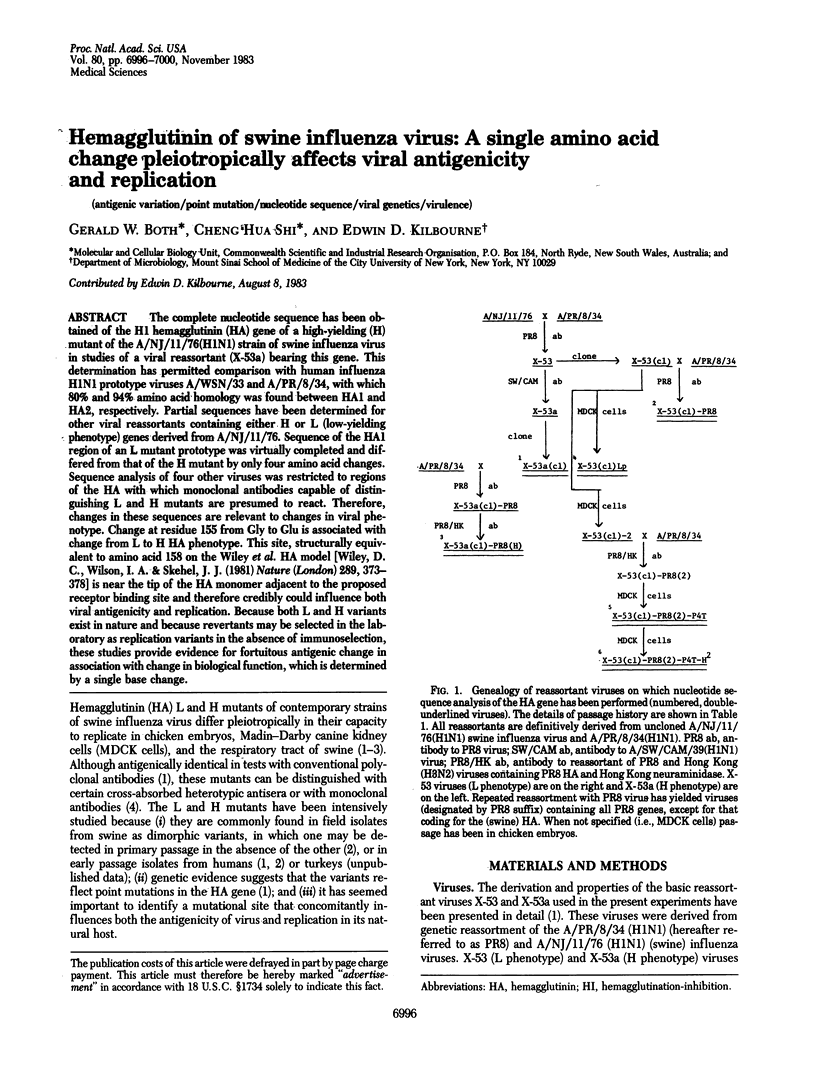
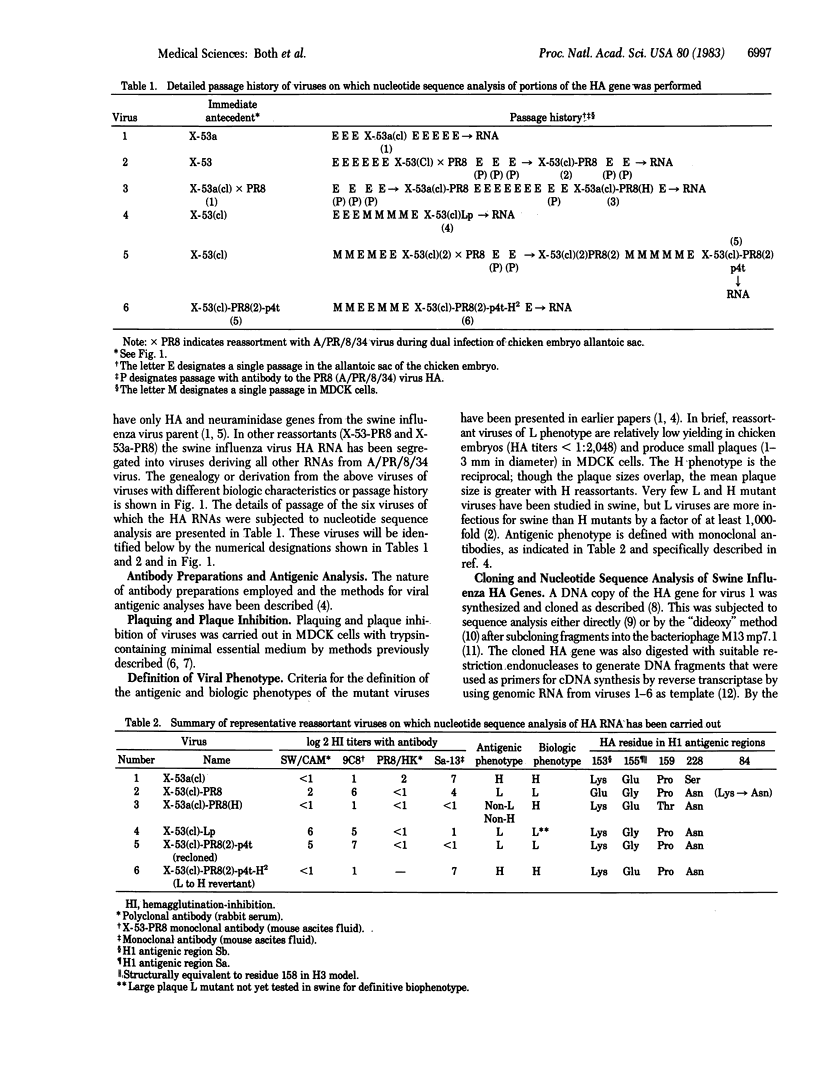
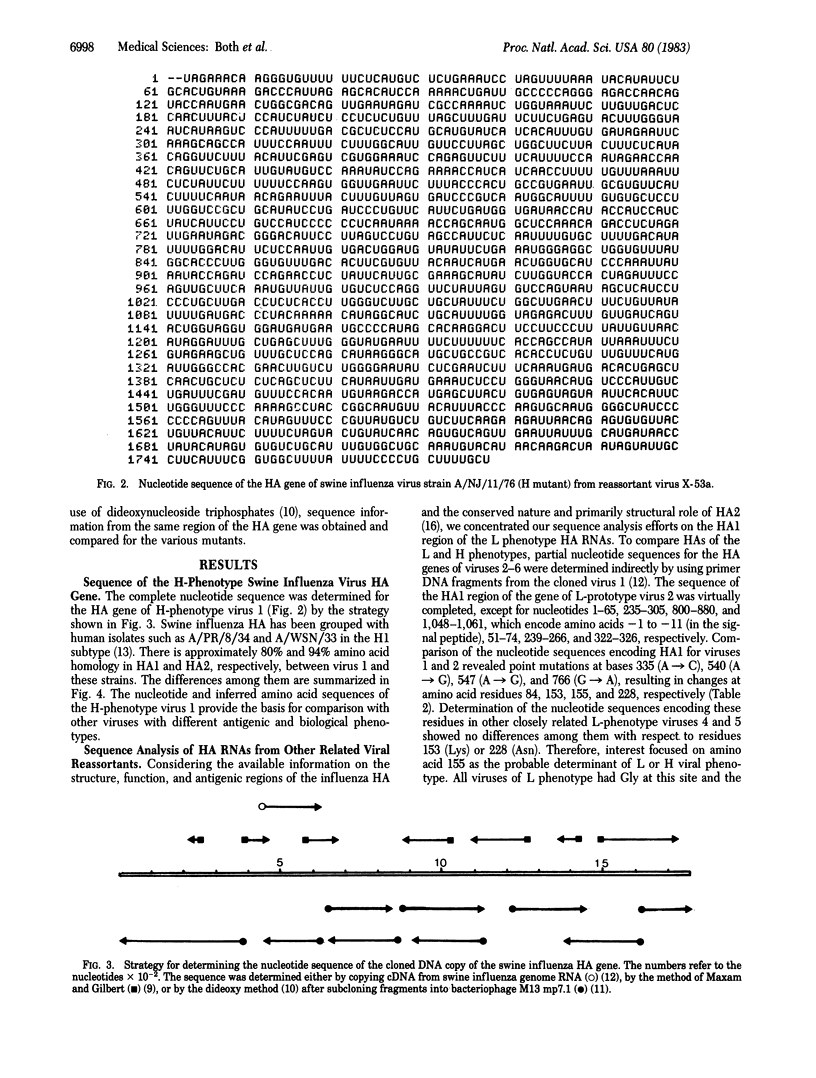
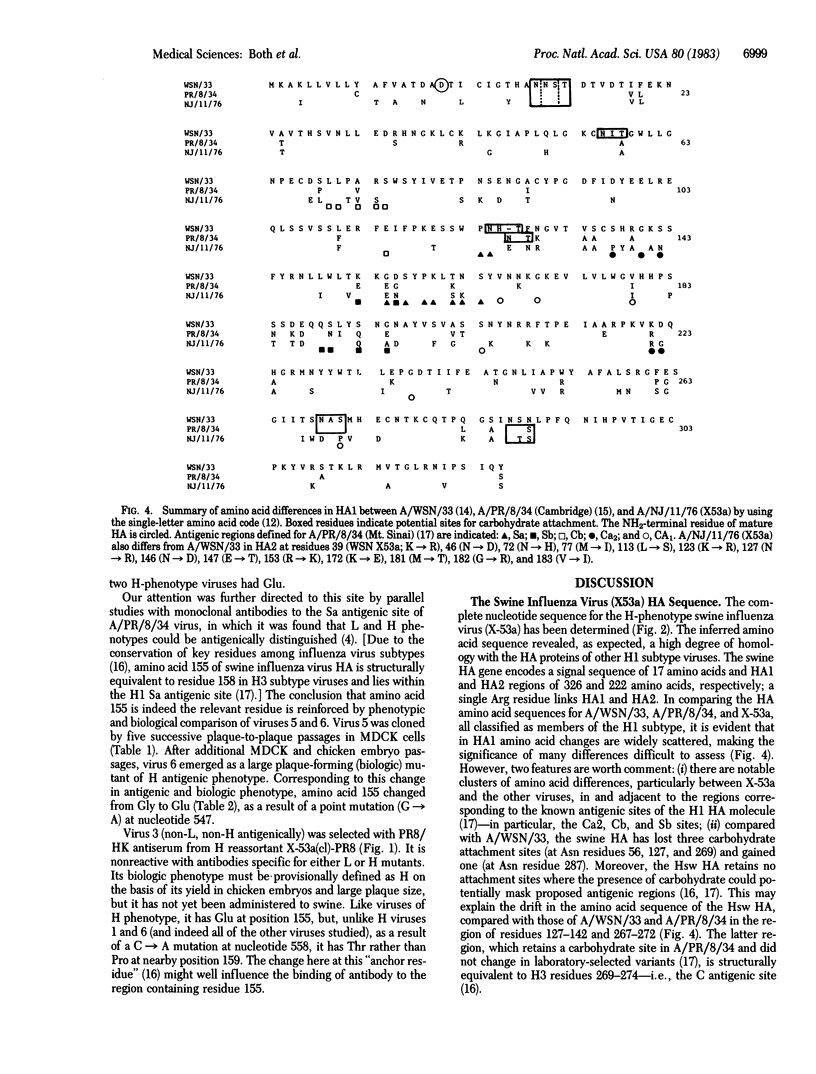
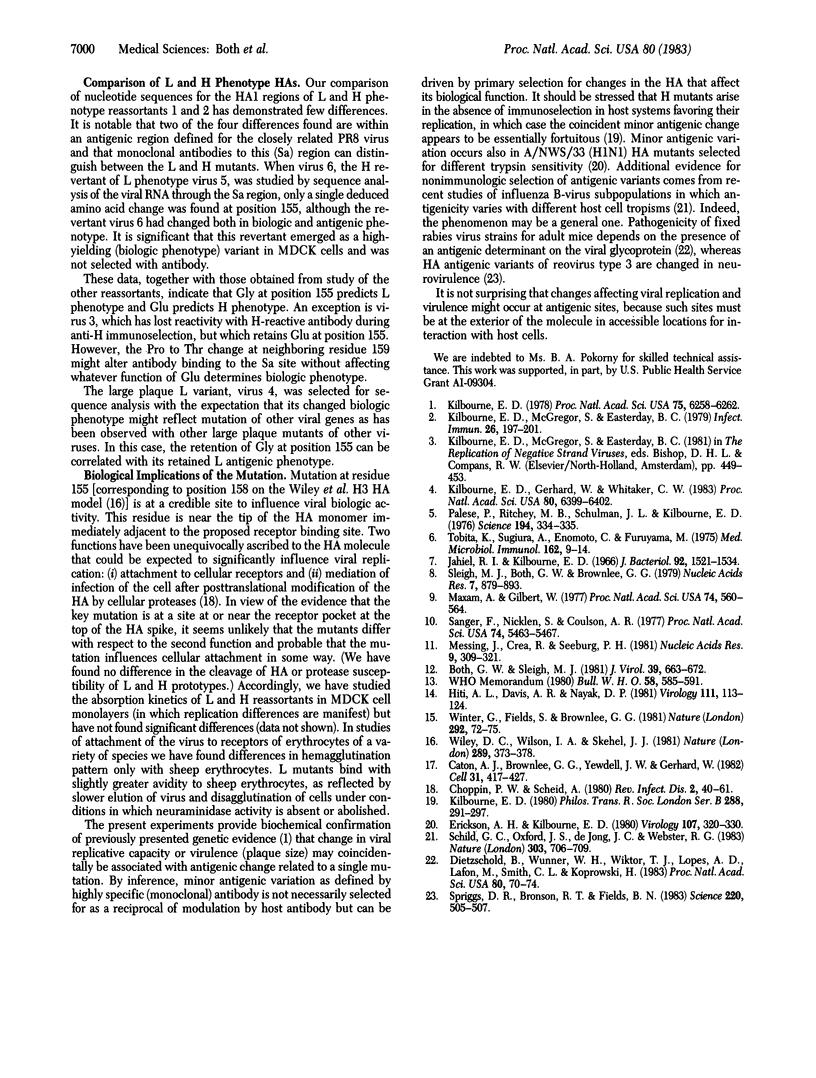
Selected References
These references are in PubMed. This may not be the complete list of references from this article.
- Both G. W., Sleigh M. J. Conservation and variation in the hemagglutinins of Hong Kong subtype influenza viruses during antigenic drift. J Virol. 1981 Sep;39(3):663–672. doi: 10.1128/jvi.39.3.663-672.1981. [DOI] [PMC free article] [PubMed] [Google Scholar]
- Caton A. J., Brownlee G. G., Yewdell J. W., Gerhard W. The antigenic structure of the influenza virus A/PR/8/34 hemagglutinin (H1 subtype). Cell. 1982 Dec;31(2 Pt 1):417–427. doi: 10.1016/0092-8674(82)90135-0. [DOI] [PubMed] [Google Scholar]
- Choppin P. W., Scheid A. The role of viral glycoproteins in adsorption, penetration, and pathogenicity of viruses. Rev Infect Dis. 1980 Jan-Feb;2(1):40–61. doi: 10.1093/clinids/2.1.40. [DOI] [PubMed] [Google Scholar]
- Dietzschold B., Wunner W. H., Wiktor T. J., Lopes A. D., Lafon M., Smith C. L., Koprowski H. Characterization of an antigenic determinant of the glycoprotein that correlates with pathogenicity of rabies virus. Proc Natl Acad Sci U S A. 1983 Jan;80(1):70–74. doi: 10.1073/pnas.80.1.70. [DOI] [PMC free article] [PubMed] [Google Scholar]
- Erickson A. H., Kilbourne E. D. Mutation in the hemagglutinin of A/N-WS/33 influenza virus recombinants influencing sensitivity to trypsin and antigenic reactivity. Virology. 1980 Dec;107(2):320–330. doi: 10.1016/0042-6822(80)90300-1. [DOI] [PubMed] [Google Scholar]
- Hiti A. L., Davis A. R., Nayak D. P. Complete sequence analysis shows that the hemagglutinins of the H0 and H2 subtypes of human influenza virus are closely related. Virology. 1981 May;111(1):113–124. doi: 10.1016/0042-6822(81)90658-9. [DOI] [PubMed] [Google Scholar]
- Jahiel R. I., Kilbourne E. D. Reduction in plaque size and reduction in plaque number as differing indices of influenza virus-antibody reactions. J Bacteriol. 1966 Nov;92(5):1521–1534. doi: 10.1128/jb.92.5.1521-1534.1966. [DOI] [PMC free article] [PubMed] [Google Scholar]
- Kilbourne E. D. Genetic dimorphism in influenza viruses: characterization of stably associated hemagglutinin mutants differing in antigenicity and biological properties. Proc Natl Acad Sci U S A. 1978 Dec;75(12):6258–6262. doi: 10.1073/pnas.75.12.6258. [DOI] [PMC free article] [PubMed] [Google Scholar]
- Kilbourne E. D., Gerhard W., Whitaker C. W. Monoclonal antibodies to the hemagglutinin Sa antigenic site of a/pr/8/34 influenza virus distinguish biologic mutants of swine influenza virus. Proc Natl Acad Sci U S A. 1983 Oct;80(20):6399–6402. doi: 10.1073/pnas.80.20.6399. [DOI] [PMC free article] [PubMed] [Google Scholar]
- Kilbourne E. D. Influenza: viral determinants of the pathogenicity and epidemicity of an invariant disease of variable occurrence. Philos Trans R Soc Lond B Biol Sci. 1980 Feb 25;288(1029):291–297. doi: 10.1098/rstb.1980.0004. [DOI] [PubMed] [Google Scholar]
- Kilbourne E. D., McGregor S., Easterday B. C. Hemagglutinin mutants of swine influenza virus differing in replication characteristics in their natural host. Infect Immun. 1979 Oct;26(1):197–201. doi: 10.1128/iai.26.1.197-201.1979. [DOI] [PMC free article] [PubMed] [Google Scholar]
- Maxam A. M., Gilbert W. A new method for sequencing DNA. Proc Natl Acad Sci U S A. 1977 Feb;74(2):560–564. doi: 10.1073/pnas.74.2.560. [DOI] [PMC free article] [PubMed] [Google Scholar]
- Messing J., Crea R., Seeburg P. H. A system for shotgun DNA sequencing. Nucleic Acids Res. 1981 Jan 24;9(2):309–321. doi: 10.1093/nar/9.2.309. [DOI] [PMC free article] [PubMed] [Google Scholar]
- Palese P., Ritchey M. B., Schulman J. L., Kilbourne E. D. Genetic composition of a high-yielding influenza A virus recombinant: a vaccine strain against "Swine" influenza. Science. 1976 Oct 15;194(4262):334–335. doi: 10.1126/science.968486. [DOI] [PubMed] [Google Scholar]
- Sanger F., Nicklen S., Coulson A. R. DNA sequencing with chain-terminating inhibitors. Proc Natl Acad Sci U S A. 1977 Dec;74(12):5463–5467. doi: 10.1073/pnas.74.12.5463. [DOI] [PMC free article] [PubMed] [Google Scholar]
- Schild G. C., Oxford J. S., de Jong J. C., Webster R. G. Evidence for host-cell selection of influenza virus antigenic variants. Nature. 1983 Jun 23;303(5919):706–709. doi: 10.1038/303706a0. [DOI] [PubMed] [Google Scholar]
- Sleigh M. J., Both G. W., Brownlee G. G. The influenza virus haemagglutinin gene: cloning and characterisation of a double-stranded DNA copy. Nucleic Acids Res. 1979 Oct 25;7(4):879–893. doi: 10.1093/nar/7.4.879. [DOI] [PMC free article] [PubMed] [Google Scholar]
- Spriggs D. R., Bronson R. T., Fields B. N. Hemagglutinin variants of reovirus type 3 have altered central nervous system tropism. Science. 1983 Apr 29;220(4596):505–507. doi: 10.1126/science.6301010. [DOI] [PubMed] [Google Scholar]
- Tobita K., Sugiura A., Enomote C., Furuyama M. Plaque assay and primary isolation of influenza A viruses in an established line of canine kidney cells (MDCK) in the presence of trypsin. Med Microbiol Immunol. 1975 Dec 30;162(1):9–14. doi: 10.1007/BF02123572. [DOI] [PubMed] [Google Scholar]
- Wiley D. C., Wilson I. A., Skehel J. J. Structural identification of the antibody-binding sites of Hong Kong influenza haemagglutinin and their involvement in antigenic variation. Nature. 1981 Jan 29;289(5796):373–378. doi: 10.1038/289373a0. [DOI] [PubMed] [Google Scholar]
- Winter G., Fields S., Brownlee G. G. Nucleotide sequence of the haemagglutinin gene of a human influenza virus H1 subtype. Nature. 1981 Jul 2;292(5818):72–75. doi: 10.1038/292072a0. [DOI] [PubMed] [Google Scholar]


